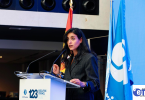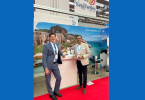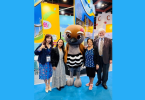A high-level delegation from Saudi Arabia has presented the eagerly awaited design masterplan for Riyadh Expo 2030 site to the delegates of Bureau International des Expositions (BIE) member countries. The groundbreaking plan promises to deliver seamless, immersive and deeply impactful experiences, catering to a record number of international visitors.
During the official reception on June 19, 2023, attended by H.R.H. Prince Mohammed bin Salman bin Abdulaziz, Crown Prince and Prime Minister, the Saudi delegation emphasized the intent behind the masterplan – to create a tangible embodiment of the proposed theme, “Era of Change: Together for a Foresighted Tomorrow.”
The delegation elaborated further at the BIE’s 172nd General Assembly the following day, outlining that Riyadh Expo 2030 will be built by the world, for the world. This concept will be integrated into every aspect of the design masterplan, reflecting the transformative journey of the Kingdom under the Saudi Vision 2030 program.
King Salman International Airport’s proximity to the Expo site, connected by the comprehensive Riyadh Metro & Bus network, ensures that arriving international visitors will only need to travel a single metro stop to reach the site. The public transit network also connects the site to the heart of the city within minutes, facilitating arrival for domestic visitors. The Expo site will feature three entrances for easy access, complemented by ample parking nearby.
The proposed Riyadh Expo 2030 site covers an area of 6.59 km² and is designed as a futuristic site around a wadi (valley). It embodies both the “oasis” and “gardens” associated with the origin of Riyadh, along with the vision of the country to pioneer a sustainable future for cities and their communities.
Indeed, the heart of the masterplan concept is our planet: the circular shape of the masterplan mirrors the earth and visitors will explore the “Loop of the World”, a broad and vibrant avenue that represents the equator connecting all of the 226 participants with their diverse country pavilions.
Participating pavilions will be flexibly arranged based on general longitude, enabling countries from the Global North and the Global South to be placed alongside each other, symbolizing the Kingdom’s pivotal role in facilitating North-South cooperation. The masterplan creates neighborhoods of pavilions with active public spaces, offering many opportunities to collaborate across all aspects of Expo, from organizing public events focused on B2B, G2G or innovation; as well as other food and cultural events that can create attractive and unique experiences for visitors.
Riyadh Expo 2030 will implement the “One Nation, One Pavilion” principle, so all nations can present their ambitions and aspirations for the future, through a dedicated pavilion.
The circular arrangement of the Expo site ensures short walking distances and easy orientation, with vibrant neighborhoods, cultural and innovative spaces, public squares, food markets, resting areas, and performance venues adorning the Loop. Visitors will be immersed in shaded narrow streets, reminiscent of the capital’s heritage, and will have the opportunity to enjoy Wadi Al Sulai, a modern oasis park that embraces Riyadh’s commitment to sustainability while preserving nature.
At the heart of the Expo site will be the Landmark, symbolizing our individual responsibility for the planet, supported by 195 columns, representing the shared responsibility of all nations.
The Landmark will be surrounded by three thematic pavilions: A Different Tomorrow, Climate Action and Prosperity for All.
Nearby is the Expo C3 area, which will be hosted within the Royal Pavilion, underlining its importance to Riyadh Expo 2030.
C3, which stands for Collaborative Change Corner, will be an engine of innovation inspiring human talent, creativity and ingenuity, during the seven-year journey to Riyadh Expo 2030 and beyond. Expo C3 builds on the best practice areas of the three most recent Expos, and will help create and fund multi-stakeholder partnerships, that advance the Sustainable Development Goals and Expo theme and sub-themes.
“Our Masterplan will create the most accessible, collaborative, and sustainable Expo ever,” said Lamia Al-Muhanna, Director of Landscape Architecture at The Royal Commission for Riyadh City.
“We will provide an unparalleled experience for more than 40 million visits, will enable the full, equal, and meaningful participation of all countries and will make sustainability the defining feature of the build and legacy of our site,” she told the delegates.
In line with its own climate commitments, Saudi Arabia has the stated aim of making Riyadh Expo 2030 the most sustainable Expo ever, going beyond carbon neutrality to achieve a net positive, an objective also reflected in the masterplan.
“We aim to become the first fully carbon-negative Expo. Our Expo site will be powered by clean energy, taking advantage of the Kingdom’s vast solar power. We are developing strict resource efficiency standards and detailed strategies to promote biodiversity, eliminate food waste, and ensure green waste management and recycling”, said Nouf Al-Moneef, Senior Director of Creative Arts at The Royal Commission for Riyadh City.
As such, it proposes to set global benchmarks for sustainability with urban greening, use of treated water and new energy sources.
With the site located at the intersection of Princess Nourah bint Abdulrahman University, King Abdullah Petroleum Studies and Research Centre, and Industrial City, the site will be re-purposed to be the new urban center for the city of Riyadh with focus on youth, innovation and creativity.






